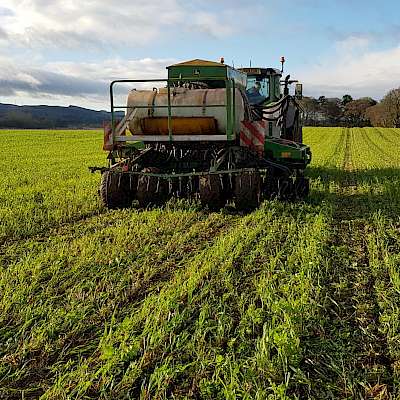Healthy soils are the life force of a thriving farm business. Yet despite its ubiquitous presence on every farm across the UK, our soil is being destroyed 10 times faster than it’s being created due to damaging practices that have diminished its fertility and health.
With 95% of global food supplies directly or indirectly produced on soil, the ground beneath our feet is key to feeding us, supporting biodiversity and storing huge amounts of carbon. As our soils are threatened, so too, is farming’s ability to maintain food production, nutritional security and viability.
As farmers, we have a major role to play in ensuring our soils are fertile and resilient. Soil restoration is a key focus at the Nature Friendly Farming Network, where we champion regenerative practices that protect and enhance our soils. After all, a farm’s livestock is as much below ground as it is above it, with one teaspoon of soil containing more living organisms than there are people in the world.
As the largest store of carbon on earth, we must do everything we can to protect and restore our soils if we have any chance of meeting ambitious net-zero targets. In the UK alone, our soils store over 10 billion tonnes of carbon in the form of organic matter, roughly equal to 80 years of annual UK greenhouse gas emissions.
As our weather is becoming increasingly volatile as a result of the climate emergency, our soils play a key part in building resilience in the face of unpredictability. In periods of drought or flooding, healthy soil is our greatest ally. Organic carbon in healthy soil can store up to 10 times its weight in water and is an excellent food source for the many microorganisms that build soil structure. Thanks to this organic matter, soil can naturally store water essential for nature and food production during dry periods, and during heavy rainfall, soak up and slow down the flow of water.
.png)
James Hopkinson, an arable farmer based in Scotland, has been committed to soil health restoration for the past five years. As a member of the Soil Regenerative Agricultural Group, set up in 2019, James is one of five farmers working collaboratively to share knowledge on soil health improvement. When James started his transition to soil-friendly practices, he began to see the benefits within two years.
“With no soil, we cannot grow crops, rear any animals nor feed the population, so it is vital to preserve and nurture our soil as humanity depends on it,” says James. “The soil regenerative system is a long-term approach and there are many different approaches to improving soil resilience. There are some short-term benefits, such as lower fuel consumption, but the real benefits come much later on such as seen through better soil drainage, carrying capacity, nutrient retention and input reduction.”
“When it comes to soil, I’m not particularly scientific about it. I like to use my spade, my eyes, my hands and my nose. For me, the decisions made on the level of tillage required is all based on the time I spend in the field with my spade, where it reveals my success or failure. This time aids me in deciding on the appropriate level of tillage and drilling techniques, or where nutrients are needed. The system creates year-round cover over the farm, in most instances for wildlife, and 10% of productive areas around every field have been put down to permanent cover for habitat that benefits wildlife, insects and pollinators.”
For more on the importance of soil health, read the NFFN’s Rethink Farming report.
1. https://www.wwf.org.uk/updates/saving-earth-sustainable-future-soils-and-water
2. https://www.fao.org/documents/card/en/c/CB1928EN/
3. https://assets.publishing.service.gov.uk/government/uploads/system/uploads/attachment_data/file/805926/State_of_the_environment_soil_report.pdf
